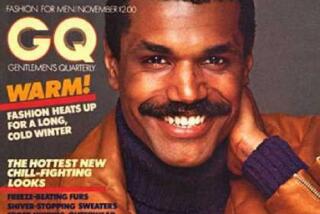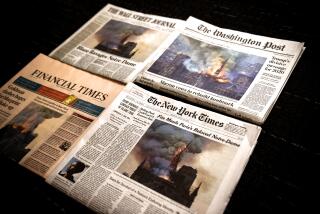Magazines Feel Increased Pressure From Advertisers
Three years ago, Ford Motor Co. canceled its advertising in the New Yorker for six months after the magazine quoted sexually graphic rock lyrics in a column published next to an advertisement for Mercury.
Last year, IBM pulled all its advertising from Fortune--and refused to talk to any Fortune reporters--after the magazine published a not altogether flattering cover story on Louis Gerstner Jr., IBMâs chairman and CEO.
The threat--and the reality--of canceled advertising has always been a risk of doing business for magazines and newspapers. But magazines have long been more vulnerable than newspapers to the consequences of their advertisersâ unhappiness, and that vulnerability makes censorship--and self-censorship--more likely.
âCensorship deprives readers of information they should have and want to have,â says Frank Lalli, senior executive editor of Time Inc. and president of the American Society of Magazine Editors. âThe public doesnât want censorship. But there is more business-side pressure on editors now than ever before.â
A New Concern
Magazine editors have to worry about revenue--about advertisers--in a way they didnât concern themselves with a decade or two ago.
With the exception of national newspapers--the Wall Street Journal, USA Today and the New York Times--newspapers rely primarily on local advertising, and despite the recent growth of other media, most large local businesses still feel they have to advertise in their major local newspaper, even when disgruntled over something that appeared in that paper. But many magazines depend on national advertising, and there are so many national magazines--not to mention the four national TV networks and the three national newspapers--that itâs a buyerâs market; an aggrieved advertiser can withdraw from virtually any magazine and put ads elsewhere without risking the loss of a significant number of customers.
Moreover, there are many news stories that newspapers must cover, often on deadline, no matter who might be offended; magazines--with fewer âmustâ stories and longer lead times--are more susceptible to pressure from advertisers. Magazine editors have âmore leeway to be good or bad,â as Kurt Andersen, former editor of New York magazine and now a columnist for the New Yorker, puts it.
Andersen was fired by New York magazine in 1996 when its owner, K-III Communications Corp., expressed dissatisfaction with its editorial tone and slow circulation growth. But Andersen and others at the magazine said he was let go at least in part because he had published several stories that upset Henry Kravis, general partner in Kohlberg Kravis Roberts & Co., which controls K-III. (K-III executives said Kravis had no role in Andersenâs dismissal.)
Andersen says that he was a victim of one of many new pressures on magazine editors--ownership by conglomerates that have little or no media experience and thus donât understand âthe correct boundaries of commerce and art. . . . The people over me had never had anything to do with magazines . . . until the last few years except to read them.â
Magazines are also more susceptible than newspapers to a growing number of other pressures. They rely heavily on newsstand sales for profits and visibility, and in a culture increasingly dominated by the cult of personality, the celebrity cover story is generally the single biggest newsstand draw; celebrities exploit this need by demanding greater and greater concessions from magazine editors, routinely refusing to grant magazine interviews unless they are promised that their picture will be on the cover--often taken by a photographer of their choice. Many also demand approval of the writer as well. No reputable newspaper would consider acceding to such conditions, but magazines--competing vigorously with one another for many of the same stories and stars--increasingly comply.
Thus, magazine editors are much more accustomed than their newspaper counterparts to taking business considerations into account on editorial matters.
In womenâs magazines, the line between news and business has long been especially fuzzy. Many advertisers routinely insist on âcomplementaryâ editorial copy to accompany their ads, and editorial features on beauty, makeup and fashion routinely include brand-name mentions of advertisersâ products. In a 1990 article in Ms. magazine, Gloria Steinem, a founding editor of the magazine, provided several examples of businesses refusing to advertise unless a magazine provided not only âcomplementaryâ but also âcompatibleâ material. Sometimes advertisers insisted that such material be placed next to their ads.
Until relatively recently, many magazines--menâs magazines, womenâs magazines and general magazines alike--also omitted one kind of story certain to offend major advertisers: stories on the connection between cigarettes and lung cancer.
Magazines, like newspapers, generally enjoyed a good year in 1997. Total magazine advertising pages increased 5.2% over 1996, the biggest year-to-year increase in revenue since 1984. But ever since the recession of the late 1980s and early â90s, magazine editors have been required to expand still further their awareness of business considerations.
âYouâre in conversations all the time with advertising and marketing people,â Lalli says. âYouâre worrying about Web sites and books and newsletters and seminar programs and youâre going on the radio and. . . . Itâs all an effort to magnify the reach and influence and profit potential of the magazine.
âThatâs not necessarily bad,â Lalli says. âIf you do it right, you build an audience and economic clout . . . and expand the franchise. . . . If you donât do it, youâll ultimately lose influence within the corporation, and your magazine will lose influence in its competitive set. . . . But once you start editing with business concerns, all this plays into your mind when youâre doing all those things that editors love to do--thinking about stories, assigning stories, reading stories, figuring out the play and the cover, and that can change what you do for your readers.â
Magazine editors are now expected to be âconscious of commercial exigencies in a way that I believe, at the serious and ambitious magazines, they were not 10 or 20 or 30 years ago,â Andersen says. âIt was possible for an editor at Esquire in 1970 to be righteously oblivious to commercial pressure, and I donât think thatâs possible now.â
Edward Kosner found that out the hard way.
Kosner, former editor of Newsweek and New York magazines, was the editor in chief of Esquire when he decided to remove from his April 1997 issue a short story by David Leavitt that included obscene language and accounts of gay sexual encounters. At the time, Kosner insisted that he killed the story only because--on final reading--he decided it was in bad taste. He still thinks it was in bad taste, but he now acknowledges that if he and his publisher, Valerie Salembier, hadnât been afraid that Chrysler Corp. would pull four pages of advertising, he would not have read the story again before publication and it would have been published.
Chryslerâs advertising agency had previously sent Esquire and more than 100 other magazines a letter demanding to be âalerted in advance of any and all editorial content that encompasses sexual, political, social issues or any editorial that might be construed as provocative or offensive.â
The letter said that whenever a magazine was scheduled to publish a Chrysler ad, it had to provide the ad agency with âa written summary outlining major theme/articles appearing in [that issue] in order to give Chrysler ample time to review and reschedule if desired.â
If Esquire complied and alerted Chrysler to the Leavitt story, Chrysler seemed likely to cancel its ads. It was a critical time for ad-impoverished Esquire, so Kosner pulled the story.
Chryslerâs letter--first reported in the Wall Street Journal last April, two months after Kosnerâs decision--triggered widespread controversy in the publishing and advertising communities. It was seen as confirmation of journalistsâ worst fears about the censorship--and self-censorship--that would inevitably occur as walls come down between editorial and advertising departments.
âPrior review has a chilling effect on editors,â Kosner says. But he doesnât challenge any advertiserâs right to withdraw from a magazine because of its content. âThis is not a 1st Amendment issue,â he says. âNo magazine editor has a 1st Amendment right to get advertising from Chryslerâ or any other client. âIndeed, it can be argued that Chryslerâs right of freedom of expression would be violated by pressure to put ads in magazines itâs not comfortable with.â
Many publishers agree with Kosner.
âIf someone goes out of the way to tell me they donât want to be in a gay issue or anything controversial, Iâd move them out,â says Nora McAniff, publisher of People magazine. âThey have a right to tell me that.â
After Ford pulled its advertising from the New Yorker in 1995, the magazine established a list of about 50 âsensitive advertisersâ who were to be alerted in advance if any potentially offensive article was about to be published. Other magazines have created less formal early warning systems. Many magazine editors think that giving advertisers that option sets a dangerous precedent.
Itâs one thing, they say, for an advertiser to pull its advertising because itâs unhappy about a published story that is unflattering to its company or its industry--or even to ask for a âheads-upâ if such a story is about to be published. Magazines often provide that warning, and advertisers will then quietly shift their advertising to another issue of the same magazine; the advertiser is satisfied, and the magazine loses no revenue.
Ruth Whitney, longtime editor in chief of Glamour magazine, recalls telling her publisher that she was about to publish a âfull-length feature about women and liquor--the dangers of drinking,â so the advertising department could alert any liquor advertisers in that issue and their ads could be moved to subsequent issues.
Breach of Editorial Independence
But most editors say itâs a breach of editorial independence when an advertiser insists on prior approval and the right to withhold advertising from a magazine that publishes any stories on a wide range of controversial subjects.
Chrysler objected to âprovocativeâ material, but for many magazines, being provocative--provoking thought and discussion--is part of the basic editorial mission.
âChryslerâs letter was a threat because other advertisers were starting to say they also wanted to see summaries, stories, tables of contents,â Lalli says. âIf several advertisers took Chryslerâs position, youâd have widespread censorship.â
Lalliâs organization and the Magazine Publishers of America joined forces to condemn advertisers who seek âprior reviewâ of editorial material, and as the criticism mounted, Chrysler backed off. In October, Mike Aberlich, manager of consumer relations for Chrysler, announced that the company âno longer wanted any kind of notification.â
But some companies that sell and distribute magazines are now demanding the same kind of prior review of magazine covers, to be sure they donât carry material that might be objectionable to their customers.
âIâm much more concerned about . . . activist groups that put pressure on magazine distributors than I am about pressure from advertisers,â says Arthur Cooper, editor in chief of GQ.
Of course, Cooper has an established, consistently ad-fat magazine riding the crest of a strong economy so he can afford to minimize the impact of demands from advertisers.
âIf you get one or two cancellations a year and you have a very diversified ad base and youâre large and profitable, you can take the hit,â says Stephen Shepard, editor in chief of Business Week and former president of the American Society of Newspaper Editors. Or, as Cooper puts it, âThe more ad pages you have, it seems, the greater your integrity is.â New, struggling magazines have a tougher time hanging on to their journalistic virtue, especially during a recession.
But not even prosperity can insulate a magazine from newsstand pressures; it doesnât matter how successful a magazine is, if it isnât displayed on the newsstand, it loses a big chunk of it circulation--and its visibility.
Itâs not just pulling a single issue of a magazine off the newsstand that worries editors and publishers, Cooper says; itâs the threat of some distributors to impose a âlifetime banâ on an offending magazine. That threat has gained strength in recent years as major retailers have begun using large, regional distributors instead of a wide variety of small, independent distributors. In less than three years, the number of independent distributors has declined almost 70%. This has left the power of distribution concentrated in fewer hands, and has made magazines more vulnerable to pressure groups.
To avoid offending those groups, Cooper says, he put two different covers on the February 1997 issue of GQ. Both featured basketball star Dennis Rodman and actress Rebecca Romijn. On the edition mailed to homes, two hands appear to have been painted over Romijnâs otherwise bare breasts; on the edition sold on newsstands, Romijnâs breasts are covered by her bathing suit top.
More to Read
Inside the business of entertainment
The Wide Shot brings you news, analysis and insights on everything from streaming wars to production â and what it all means for the future.
You may occasionally receive promotional content from the Los Angeles Times.










